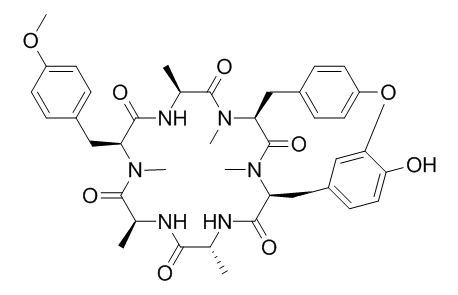RA-V
RA-V is an potential anti-angiogenic agent, exhibits anti-angiogenic activities in HUVEC and HMEC-1 cell lines with changes in function of these endothelial cells. RA-V also has anti-cancer activity, is a potential anti-metastatic agent in breast cancer, and likely acts via PI3K/AKT and NF-κB signaling pathways in both ER-positive and ER-negative breast cancer cells.
Inquire / Order:
manager@chemfaces.com
Technical Inquiries:
service@chemfaces.com
Tel:
+86-27-84237783
Fax:
+86-27-84254680
Address:
1 Building, No. 83, CheCheng Rd., Wuhan Economic and Technological Development Zone, Wuhan, Hubei 430056, PRC
Providing storage is as stated on the product vial and the vial is kept tightly sealed, the product can be stored for up to
24 months(2-8C).
Wherever possible, you should prepare and use solutions on the same day. However, if you need to make up stock solutions in advance, we recommend that you store the solution as aliquots in tightly sealed vials at -20C. Generally, these will be useable for up to two weeks. Before use, and prior to opening the vial we recommend that you allow your product to equilibrate to room temperature for at least 1 hour.
Need more advice on solubility, usage and handling? Please email to: service@chemfaces.com
The packaging of the product may have turned upside down during transportation, resulting in the natural compounds adhering to the neck or cap of the vial. take the vial out of its packaging and gently shake to let the compounds fall to the bottom of the vial. for liquid products, centrifuge at 200-500 RPM to gather the liquid at the bottom of the vial. try to avoid loss or contamination during handling.
Nature Ecology & Evolution2020, doi: 10.1038
Separations2021, 8(6),80.
Evid Based Complement Alternat Med.2019, 2019:2135351
Pharmaceuticals.2022, 15(4), 402.
Biomed Pharmacother.2024, 171:116166.
Sci Rep.2016, 6:25094
Molecules 2022, 27(3),1047.
International. J. of Food Properties 2017, 20:S131-S140
Phytother Res.2022, 10.1002:ptr.7626.
Antioxidants (Basel).2022, 11(8):1471.
Related and Featured Products
Toxicol Appl Pharmacol. 2013 Feb 15;267(1):95-103.
Plant cyclopeptide RA-V kills human breast cancer cells by inducing mitochondria-mediated apoptosis through blocking PDK1-AKT interaction.[Pubmed:
23274515]
In the present paper, we examined the effects of a natural cyclopeptide RA-V on human breast cancer cells and the underlying mechanisms.
METHODS AND RESULTS:
RA-V significantly inhibited the growth of human breast cancer MCF-7, MDA-MB-231 cells and murine breast cancer 4T1 cells. In addition, RA-V triggered mitochondrial apoptotic pathway which was indicated by the loss of mitochondrial membrane potential, the release of cytochrome c, and the activation of caspase cascade. Further study showed that RA-V dramatically inhibited phosphorylation of AKT and 3-phosphoinositide dependent protein kinase 1 (PDK1) in MCF-7 cells. Moreover, RA-V disrupted the interaction between PDK1 and AKT in MCF-7 cells. Furthermore, RA-V-induced apoptosis could be enhanced by phosphatidylinositol 3-kinase inhibitor or attenuated by over-expression of AKT in all the three kinds of breast cancer cells.
CONCLUSIONS:
Taken together, this study shows that RA-V, which can induce mitochondria-mediated apoptosis, exerts strong anti-tumor activity against human breast cancer. The underlying anti-cancer mechanism of RA-V is related to the blockage of the interaction between PDK1 and AKT.
Br J Pharmacol. 2011 Dec;164(7):1883-98.
Cyclopeptide RA-V inhibits angiogenesis by down-regulating ERK1/2 phosphorylation in HUVEC and HMEC-1 endothelial cells.[Pubmed:
21518338]
A cyclopeptide, RA-V, has been shown to have anti-tumour activities. Its in vitro anti-angiogenic activities were evaluated in the present study, and the underlying mechanisms were also assessed.
METHODS AND RESULTS:
Two endothelial cell lines, human umbilical vein endothelial cells (HUVEC) and human microvascular endothelial cells (HMEC-1), were used. The effects of RA-V on the proliferation, cell cycle phase distribution, migration, tube formation and adhesion were assessed. Western blots and real-time PCR were employed to examine the protein and mRNA expression of relevant molecules. RA-V inhibited HUVEC and HMEC-1 proliferation dose-dependently with IC(50) values of 1.42 and 4.0 nM respectively. RA-V inhibited migration and tube formation of endothelial cells as well as adhesion to extracellular matrix proteins. RA-V treatment down-regulated the protein and mRNA expression of matrix metalloproteinase-2. Regarding intracellular signal transduction, RA-V interfered with the activation of ERK1/2 in both cell lines. Furthermore, RA-V significantly decreased the phosphorylation of JNK in HUVEC whereas, in HMEC-1, p38 MAPK was decreased.
CONCLUSIONS:
RA-V exhibited anti-angiogenic activities in HUVEC and HMEC-1 cell lines with changes in function of these endothelial cells. The underlying mechanisms of action involved the ERK1/2 signalling pathway. However, RA-V may regulate different signalling pathways in different endothelial cells. These findings suggest that RA-V has the potential to be further developed as an anti-angiogenic agent.
Biochim Biophys Acta. 2015 Aug;1850(8):1827-40.
Cyclopeptide RA-V inhibits cell adhesion and invasion in both estrogen receptor positive and negative breast cancer cells via PI3K/AKT and NF-κB signaling pathways.[Pubmed:
25953046]
Cyclopeptide RA-V has potent anti-tumor and anti-angiogenic activities, but its potential anti-metastatic activity is unknown. Cancer cells acquire invasive ability to degrade and adhere to extracellular matrix (ECM), allowing them to migrate to adjacent tissues and ultimately metastasize.
METHODS AND RESULTS:
Hence, the present study aimed to investigate the effects of RA-V on cell adhesion, migration, invasion and matrix degradation, and its underlying mechanism in two human breast cancer cell lines MCF-7 (ER-positive) and MDA-MB-231 (ER-negative). Our results demonstrated that RA-V (12.5nM) can significantly inhibit breast cancer cell adhesion and migration via interfering cofilin signaling and chemokine receptors involved in cell migration. RA-V reduced the expressions of vascular intracellular adhesion molecule (VCAM), intracellular adhesion molecule (ICAM), focal adhesion kinase (FAK) and integrins. The activities and expressions of matrix metalloproteinases (MMPs), tissue inhibitors of matrix metalloproteinases (TIMPs) and urokinase-type of plasminogen activator (uPA) were also inhibited by RA-V. Furthermore, RA-V inhibits the expressions of EGFR, PI3K/AKT and NF-κB signaling molecules, and reduces the binding of β-estradiol to ER via affecting binding ability of ER in MCF-7 cells.
CONCLUSIONS:
RA-V inhibits breast cancer cell migration, adhesion and ECM degradation in vitro, implying that RA-V is a potential anti-metastatic agent in breast cancer, and likely acts via PI3K/AKT and NF-κB signaling pathways in both ER-positive and ER-negative breast cancer cells.



